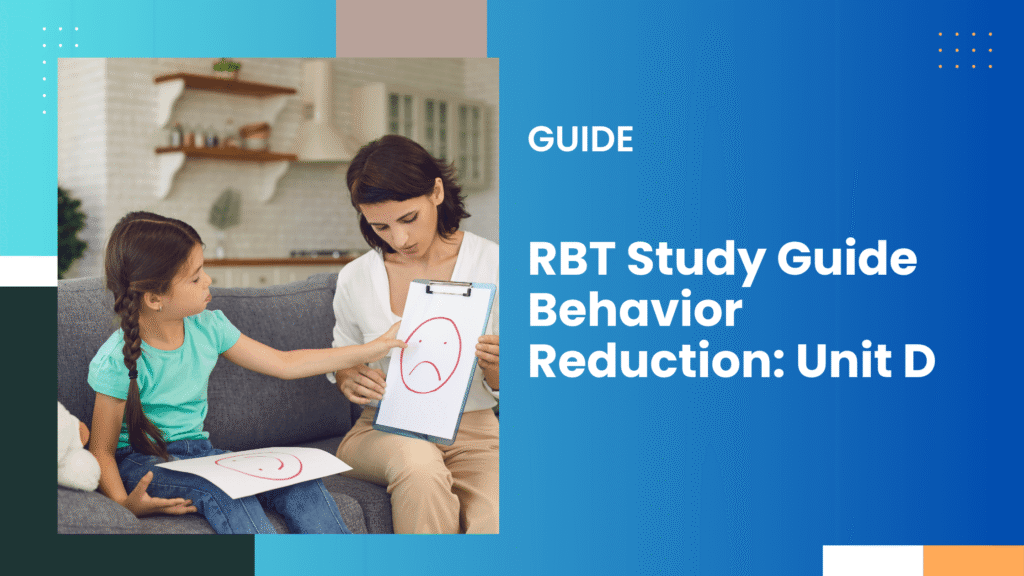
Prepare for your RBT Study Guide on Behavior Reduction: Unit D. Take our Mock Test. Practice for real exam scenarios. It’s free and educational.
1. Identify Essential Components of a Written Behavior Reduction Plan
First of all, A Behavior Reduction Plan (BRP) or Behavior Intervention Plan (BIP) is important in helping clients who exhibit challenging behaviors.
To help you with that, I have compiled a few essential components of a written behavior reduction plan:
- Client Information: It will include the client’s name, age, and background information to provide context.
- Behavioral Goals: You also need to clearly define the specific behaviors to reduce. For example, make clear goals such as “Reduce aggressive outbursts by 50% within three months.”
- Data Collection Methods: Next, I want you to outline how data will be collected and use methods like frequency recording or interval recording to track progress.
- Intervention Strategies: For this specifically, it includes reinforcement techniques or changes to the environment.
- Crisis Management Plan: Include steps for managing severe behaviors that may pose risks.
- Responsible Parties: Clarify who will be the one implementing the plan, like the Registered Behavior Technician (RBT) or Board Certified Behavior Analyst (BCBA).
- Review Schedule: This one is simple, simply specify how often the plan will be reviewed and updated. You must also do Regular check-ins to help keep the plan effective.
2. Implement interventions based on modification of antecedents such as motivating operations and discriminative stimuli
You know, Modifying antecedents can significantly impact behavior?
The thing is, Antecedents are events or situations that happen before a behavior occurs. So, by changing these, you can influence how a person acts.
Motivating Operations: These are factors that change how much a person wants something.
For example, if a child is hungry, they may seek out food more actively. So, your response will be to provide snacks regularly to reduce this kind of behavior.
Discriminative Stimuli (SDs): Another kind of signals that indicate when a behavior will be reinforced is if a student knows that raising their hand in class leads to being called on, they are more likely to do it.
Clear and consistent signals can help guide desired behaviors.
Strategies for Implementation
My personal advice to approach these types of questions will be to:
- Change the Environment: Simply rearrange the setting, and it can help reduce unwanted behaviors. Let’s say that keeping distractions away during study time can improve focus. (This is a fact and common sense too)
- Use Visual Aids: How about using Charts or schedules to help remind individuals of expected behaviors?
- Provide Choices: Allowing choices can increase motivation and reduce problem behaviors. For example, let a child choose between two tasks rather than you choosing it for them.
3. Describe Common Functions of Behavior
In Applied Behavior Analysis (ABA), behaviors occur for specific reasons.
These reasons are known as functions of behavior, and here are the four main functions of it:
- Attention: Some behaviors do happen because an individual wants attention from others, from talking, yelling, or acting out, to be noticed.
- Escape/Avoidance: This is an escape tactic, and People may engage in behaviors to escape or avoid certain situations or even refuse to do tasks they find difficult or unpleasant.
- Access to Tangibles: This function involves behaviors aimed at getting something they want, like toys or food. Examples include asking for a snack or throwing a toy to get a desired item.
- Sensory Stimulation: Such as spinning, rocking, or making noises to satisfy a personal need for sensory input and an outlet.
If you understand why behavior occurs, I am confident you have already crossed halfway to developing Behavior Intervention Plans (BIPs) that can teach more appropriate behaviors.
4. Implement differential reinforcement procedures (e.g., DRA, DRO)
For this technique, it can be used to encourage positive behavior while at the same time reducing unwanted actions.
This can be broken down into a few key methods: DRA (Differential Reinforcement of Alternative Behavior) and DRO (Differential Reinforcement of Other Behavior).
DRA (Differential Reinforcement of Alternative Behavior)
- What is it? You basically reinforce a desired behavior while not reinforcing an undesired one. Like substituting a good one for a bad one.
- Example: If a child asks for a break instead of acting out, you praise or reward them for the request.
DRO (Differential Reinforcement of Other Behavior)
- What is it? In simple terms, you then reinforce the absence of an undesired behavior for a specific period.
- Example: A Child goes ten minutes without yelling, then you give them positive feedback or a reward.
5. Implement extinction procedures
This one is interesting, as using the Extinction function is a key behavior reduction technique.
It involves withholding reinforcement for a behavior that has been previously rewarded and helps reduce the frequency of that behavior over time.
Steps for Implementing Extinction:
- Identify the Behavior: I want you to choose the behavior you want to reduce.
- Assess Reinforcement: Next, think and determine what is reinforcing this behavior. Use many of the examples, such as attention, items, or activities.
- Withhold Reinforcement: Once you have an idea, stop providing the reinforcement when the behavior occurs and just ignore the behavior.
- Monitor Progress: Do that every time and then keep track of how often the behavior happens.
Important Considerations:
- Consistency is key: For this method to work, consistency is key. You can’t be giving Mixed messages to the child, as it can confuse the individual.
- Temporary Increase in Behavior: Be ready for a possible increase in behavior at first. This is called an “extinction burst.”
Example:
In our scenario, let’s imagine there’s a child who frequently shouts to get attention; now we want to ignore the shouting.
Instead, give attention when the child is quiet or engages in positive behavior.
So, by using extinction properly, you can effectively reduce unwanted behaviors over time.
6. Implement crisis/emergency procedures according to protocol
Lastly, when you’re working as a Registered Behavior Technician (RBT), knowing how to handle crises is essential.
You will come across many crises and need to implement emergency procedures effectively.
1. Follow the Protocol
You need to always stick to the specific procedures outlined by your supervising Board Certified Behavior Analyst (BCBA).
These written plans are detailed with the steps to take during a crisis.
2. Identify the Crisis Behavior
Take some time to fully understand and decide if it could be harmful behavior, like aggression or self-injury.
Knowing this behaviour exactly will help you respond quickly.
3. Prioritize Safety
Your first job is to ensure safety.
That means, don’t panic and keep control of yourself, the client, and others in the area safe during an emergency.
4. Communicate Clearly
Notify the caregiver immediately if a child is injured.
See if everyone is alright and make sure everyone involved knows what steps to take.
5. Document the Incident
After the crisis, fill out an incident report.
Record details about what happened, how you responded, and what actions were taken.
This is important for follow-ups and evaluations.
